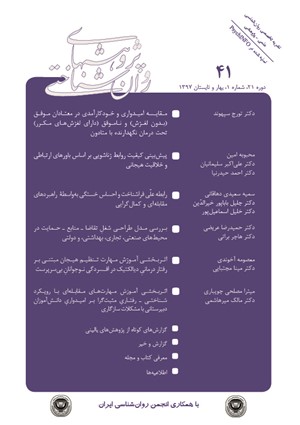بررسي مدل طراحيِ شغلِ تقاضا ـ منابع ـ حمايت در محيط هاي صنعتي، تجاري، بهداشتی، و دولتي
محورهای موضوعی :
حمیدرضا عریضی
1
![]() ,
هاجر براتی
2
,
هاجر براتی
2
1 - دانشگاه اصفهان
2 - دانشگاه اصفهان
کلید واژه: تقاضاهای شغلی کنترل شغلی حمایت اجتماعی محیطهای سازمانی,
چکیده مقاله :
یکی از مدل های بررسی تأثیر تقاضاهای شغلی بر کارکنان، مدل تقاضا ـ منابع ـ حمایت است. این پژوهش با هدف بررسي مدل طراحيِ شغلِ تقاضا ـ منابع ـ حمايت در محيط هاي صنعتي، تجاري، بهداشتی، و دولتي انجام گردید. نمونههای پژوهش از 4 بخش یعنی صنعت (928=n)، بيمارستان (526=n)، تجارت (483=n)، و سازمان هاي دولتي (582=n) انتخاب شدند. سپس این افراد، به ابزارهای پژوهش شامل پرسشنامههای زمان، تلاش جسمی، استقلال، بهکارگیری مهارت، حمایت اجتماعی، ایمنی شغلی، خشنودی از وظیفه، تعهد سازمانی، و خستگی پاسخ دادند. ارزیابی برابری سنجش در بین جمعیتها در این چهاربخش از طریق فنون ثبات عاملی آزمون شد. یافته ها نشان دادند که مدل ششعاملی هم از نـظر شاخصهاي مجـذوركاي (به تـرتيـب، در صنعت 85/1، در بيمارستـان 67/1، در تجارت 71/1، و در سـازمان-هاي دولتـي 92/1)، و هم از نظـر شـاخصهـاي مطلق و تفصيلي (اين مقادير در هر چهار گروه فقط در مدل پنجم به سطح مطلوب 90/0 ميرسند)، همچنین از نظر شاخص هاي باقيمانده (اين مقادير در هر چهار گروه فقط در مدل پنجم كمتر از 04/0 هستند)، در مقایسه با سایر مدل ها از برازش بهتری برخوردارند. همچنین، نتایج نشان دادند که بهکارگیری مهارت در هر چهار بخش خشنودی از وظیفه و تعهد سازمانی را پیشبینی میکند. در هر چهار بخش، عامل زمان نیز پیشبین خستگی است و حمایت اجتماعی نیز هر سه متغیر خشنودی از وظیفه، تعهد سازمانی، و خستگی را پیشبینی میکند.
To investigate the effects of job demands on employees in job design, several models have been developed. One of these models is demand-resource-support model. It seems that this model varies in different orga-nizational workplaces because of special fea-tures of these settings. This study was conduc-ted to investigate the demand-resources-sup-port job design model in the industrial, finan-cial, healthcare, and public workplaces. The re-search samples were selected from four sec-tors, namely industry (n=928), healthcare (n=526), financial department (n=483), and public organizations (n=582). The samples res-ponded to research instruments consisting of Time, Physical Effort, Autonomy, Skill Utili-zation, Social Support, Occupational Safety, Task Satisfaction, Organizational Commitment,and Fatigue Questionnaires. Evaluation of mea-surement equivalence in four selections were tested via factor invariance technique. The re-sults showed that the six-factor model has a better fit than other models both in terms of the chi square indexes (respectively, in indus-try=1.85, in hospitals=1.67, in business =1.71, in governmental organizations =1.92) and in terms of absolute and detailed indexes (in all four groups, these values only reach to optimal levels=0.90 in the fifth model), as well as in terms of residual indexes (the amounts in all four groups in the fifth model were less than 0.04). The results showed that, in all four sections, skill utilization predicts task satis-faction and organizational commitment. The required time factor predicts the fatigue, and social support predicts all three variables of task satisfaction, organizational commitment, and fatigue.
